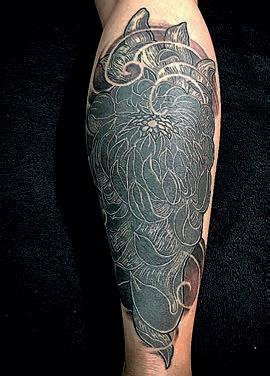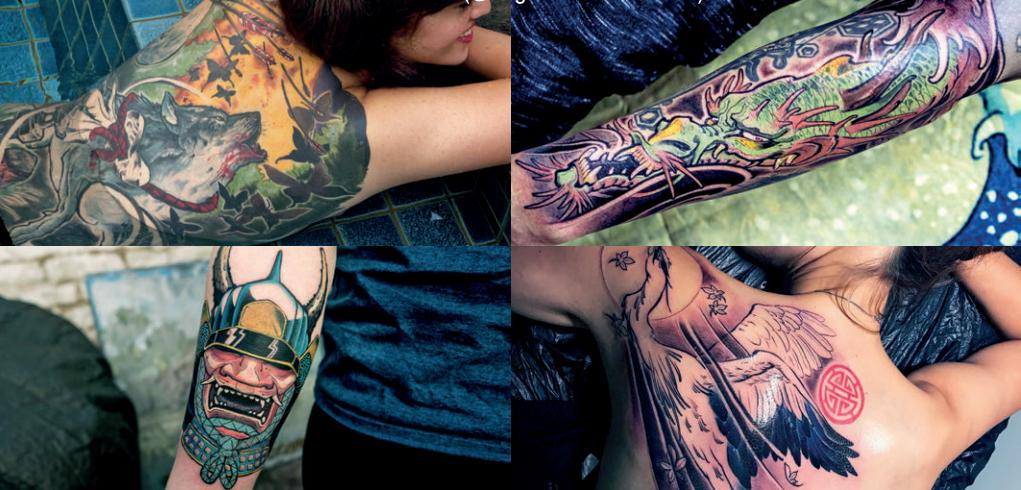Tattoos have come a long way in Singapore - gone are the days when body art was synonymous with gang poems, barbed wires and butterflies. We ask two local tattoo artists who have been in the industry for almost 20 years to walk us through the evolution of tattoos over the past three decades.


Tattoos have come a long way in Singapore - gone are the days when body art was synonymous with gang poems, barbed wires and butterflies. We ask two local tattoo artists who have been in the industry for almost 20 years to walk us through the evolution of tattoos over the past three decades.
The two local tattoo artists we spoke to:
Anthony Yeo
First Tattoo Studio
facebook.com/FirstTattooStudio
Started tattooing in 1999 and opened his first shop in the same year. He’s best known for his Japanese- inspired designs.
Samuel Yar
Of Gods & Monsters Tattooing
@of.gods.and.monsters
Started tattooing in 1999 and opened his first shop in 2005. He’s also known for his Japanese-inspired designs.

Late ’80s
This was a period when tattoos were closely associated with secret societies. “At that time, only gangsters had tattoos,” says Anthony. “And when they were caught by the CID, they had to cancel their tattoos out with ‘nets’ (see picture on the bottom left).” Tattoos were almost exclusively seen on gangsters at the time, which explains why they still signify rebellion to this day to some folks.
Popular designs: Gang poems and logos, dragons, tigers, phoenixes and Yin Yang symbols with flames

Look closely and you’ll see a gang tattoo that was “cancelled out”.

While this gang poem is on his chest, Samuel says students who had such tattoos usually had them on their thighs to hide them from their parents.

Early ’90s
Up till the early ’90s, the process of getting a tattoo was somewhat like ordering fast food: one could only choose from templated designs that were numbered. “In those days, there was no customisation involved. Tattoo artists got their designs from flash sheets sold by [then-popular tattoo artists] David Bolt, Paul Booth and Edward Lee,” says Samuel. Naturally, this meant that many people had the same designs.
Popular designs: Barbed wire, Celtic knotwork, tribal dragons, Red Indian chiefs, butterflies and dolphins
“Celebrities had a lot of influence over what sort of tattoo designs people got. Many people got Celtic knotwork stuff because of Pamela Anderson, and those who got a tribal dragon were inspired by the one on Billy Bob Thornton.” - Samuel

Late ’90s
It was during this period that people started getting designs of beasts such as dragons. “People started getting tattoos that extended from the chest to the arm,” says Anthony. “Tattoo artists weren’t really familiar with the Internet yet, so we could only get inspiration from tattoo magazines, which were available in certain bookstores.”
Popular designs: Wizards, panthers, roses, “cute bat”, “baby devil”, and American Traditional (old school Western designs)
“The ‘baby devil’ design was popular among women who wanted to give the ‘naughty girl’ impression.” - Samuel

Early 2000s
Popular designs: Lower back tribal designs (sometimes referred to as “tramp stamps”), Chinese names (usually a literal translation of an English one), demons, skulls, bulldogs, and monochrome portraits

@anthonyyeo13
Mid-2000s
Tattoos became more widely accepted as a form of artistic expression – and less associated with gangsterism – as people started to acknowledge that tattoos can have personal meanings.
Popular designs: Biomechemical “skin tears”, angel with wings, Blackwork (distinctive motifs with bold, black shading)
“So many people got the angel with wings because of David Beckham. I must have done a good 200, and that was just me alone. There must have been a lot more out there.” - Samuel

@anthonyyeo13
Late 2000s
This was when tattoo designs really started to evolve. “Miami Ink changed the game altogether. People started to get a wider range of designs – basically, everything else but dragons and wizards,” says Samuel. “Also, everyone started getting bigger pieces. More people became accepting of tattoos, so people started getting full back tattoos, full sleeves and even bodysuits.”
Chunky, black designs became a thing and many people would cover their arms or even scalps with an all-black piece.
Popular designs: Oil lamps, Mexican sugar skulls, sayagata (interlocking swastikas) and Blackout (huge blocks of black)

@anthonyyeo13
2000-2016
Popular designs: Coloured portraits, triangles, mandalas, finger twists, calligraffiti, feather “breaking” into silhouettes of birds (which usually means “to set free”), dotwork, watercolour designs, Neo Traditional (a twist on old school Western styles)

@of.gods.and.monsters
2018
The tattoo style of the moment? #trendytattoos. “It’s an actual hashtag on social media platforms such as Pinterest,” says Samuel. #trendytattoos are usually small, dainty and, well, “modern”. They also come in all sorts of designs.

Anthony’s work (@anthonyyeo13)

Samuel’s work (@of.gods.and.monsters)
The enduring appeal of Japanese style tattoos
Anthony and Samuel agree that the popularity of Japanese style tattoos has never diminished. “It has remained the same since Day One and is still going strong,” says Samuel. “It’s always popular because of the way the style is structured – the contrast and composition are well thought out. Also, the designs are usually related to folklore, and people like the reminder.”
What’s it like being a female tattoo artist in Singapore?
Once a male domain, there has been a sharp rise in the number of female tattoo artists here. We talk to two of them.

Jen Tan @jenxtattoos
Jen is known for tattoos done in her handwriting (look up #jenxwritten on Instagram to check them out), fine line work, and animals – particularly cats.
“I’ve been tattooing for almost eight years. It was definitely a male-dominated industry in the early days and it was difficult for female tattoo artists to be accepted, much less to find their niche. But today, we’re getting more recognition. I believe this is because people are now more broad-minded and acknowledge that art can come in different forms – and that the gender of the artist doesn’t matter.
In the past, the common assumption about women with tattoos was that they’re ‘bad’ or ‘uncultured’. Our job was also seen as ‘improper’. However, I’m grateful that people are now more accepting of tattoos, and though we still have some way to go, we have come quite far.
I haven’t really had any super bad experiences as a female tattoo artist, but sometimes, I’ll get a comment like, ‘Oh, so you can’t do bold and masculine work for men? I guess I need to find a guy who can do it.’ To clarify: it’s not that I can’t, it’s just that I’ve developed my own style and it has a feminine and organic flair. An artist’s tattoo style doesn’t have anything to do with their gender, but their preference and versatility.”

Lee Wai Leng @fleecircus
Wai Leng is known for monochromatic line work and nature-themed tattoos.
“There has been a rise in the number of tattoo artists in Singapore – not just female ones. I suppose one of the reasons for this is that many of the stigmas that were associated with tattoos have vanished, and tattoos are increasingly accepted as a form of personal artistic expression.
In my opinion, the gender discrimination or inequality female tattoo artists face is the same kind faced by women in other work environments. But at the end of the day, what matters most is the quality of the final ink, and the work is something that cannot be discriminated against. Any misconceptions about gender usually vanishes when the work is completed.”
Are tattoos in the workplace OK in this day and age?
We ask seven companies across various industries.
"As an inclusive employer, we do not discriminate against employees who have tattoos. That said, our employees are mindful that there could be some members in the community who are uncomfortable being served by individuals with visible tattoos. If and when such instances arise, they will exercise their discretion in allaying the individual’s concern so that a meaningful customer experience is duly delivered. For example, if a customer feels uncomfortable being served by a staff at a bank branch who has a visible tattoo, the branch manager will assign another staff to serve this customer.”
Ms Jacinta Low, Head of HR Planning at OCBC Bank (Staff count: 8,000 in Singapore)
"We do not have any policies on visible tattoos at our company.”
Ara Hampartsoumian, Managing Director at TBWASingapore (Staff count: 280)
"We don’t have any specific policy on visible tattoos. As long as one delivers results that matter to ShopBack and fits our company culture, we’re impartial.”
Alex Teo, Head of People Operations at ShopBack (Staff count: 150)
"At Dandy and across our venues – Neon Pigeon, Summerlong, Fat Prince and The Ottomani – we build our teams on attitude and experience. We encourage our teams to express themselves and to bring their own personalities each day. Should that include tattoos, then so be it. Guests love an experience where they can connect with the team, and would not want to put restrictions on [our staff].”
Ben Hosford, Group Director of Operations at Dandy Partnership (Staff count: 60)
"The company does not have a policy on tattoos or piercings. We respect an individual’s right to do what they want so long as they, as a representative of the company, behave and present themselves with decorum, especially at work.”
Singapore Press Holdings Human Resources Division (Staff count: 4,100)
"Robert Walters Singapore embraces diversity in the workplace, and as a company, we hire and retain based on skills and merit. Currently, we do not have any HR policies against body art, though we expect our employees to look professional, so any visible large body art should be covered up accordingly. We request employees to exercise discretion in such instances and apply the age-old ‘red face test’ – if the visible body art provokes discernible embarrassment or discomfort, one should reconsider its appropriateness in the workplace.”
Tricia Tan, HR Director at Robert Walters South East Asia (Staff count: 150)
"At the moment, we do not have an official policy to govern tattoos on employees. However, while we do not restrict our employees from having tattoo(s), employees are expected to dress in a professional manner, especially if they are meeting any external parties. The same expectation applies throughout the firm.”
A Singapore-based architectural firm
Cover image Anthony Yeo/First Tattoo Studio
Images Anthony Yeo/First Tattoo Studio, Samuel Yar/Of Gods & Monsters Tattooing























